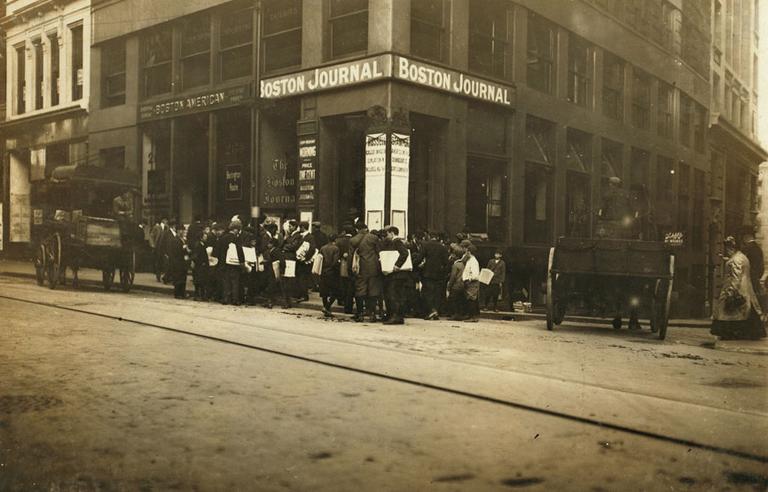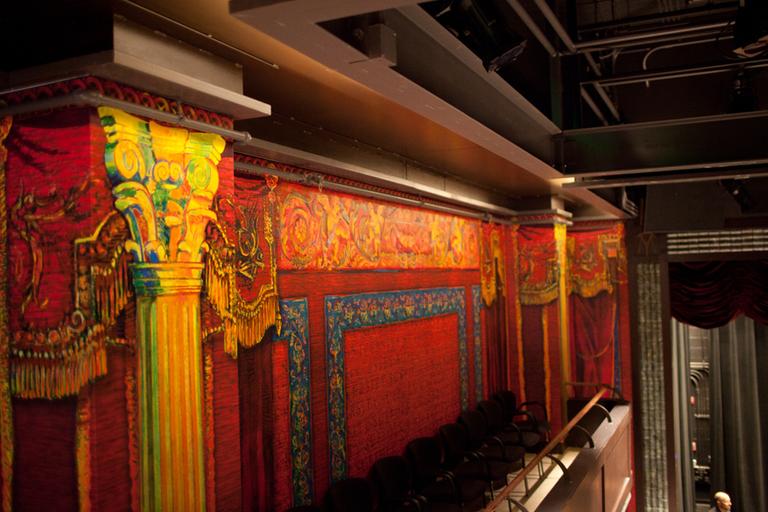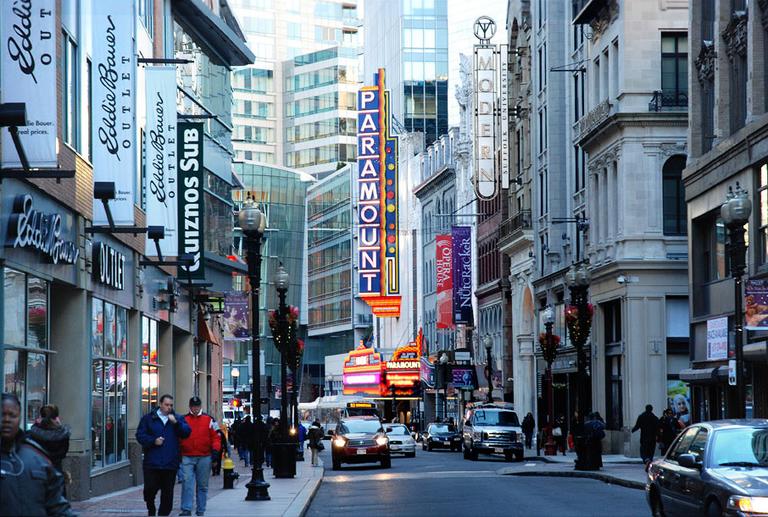Advertisement
Reclaiming The Glory Of Washington Street's Past
ResumeDecember is when the ghosts of Christmas past haunt Downtown Crossing and Washington Street. Jordan's and Filene's are gone, and with them went the Enchanted Village and Christmas tree lighting.
But this year has also brought a rebirth of two historic theaters. The Paramount and the Modern Theatre now join the restored Opera House.
City and business leaders call these the "Three Sisters" — the jewels that will make Washington Street and Downtown Crossing shine once again.
WBUR's Andrea Shea and David Boeri took a walking tour of the area — and they took a look back at the kind of excitement the city would like to revive. Here are their stories.
We started on the corner of Washington and Water Streets. Nearby we could see a Starbucks, a Toys 'R' Us and the Vitamin Shoppe.
These are the landmarks for what was once Newspaper Row. The Starbucks is on the site of the old Boston Globe, the Toys 'R' Us was the Boston Post, and the Vitamin Shoppe used to be the Boston Journal. There were once as many as 17 newspapers operating in this narrow strip. Back in the 1950s, this place was jumping.
"It was the center of the city, the center," says Ron Wysocki as we stroll where the Row once stood.
In 1954, Wysocki was a quick study of a copy boy for the Boston Globe at 244 Washington Street, which is now the Devonshire Building. He was on a fast track to a byline on the front pages.
"City Hall was around the corner," he says, "the State House was up the street, federal building, federal courthouse was right there. You could stand in the front of the Globe for an hour and see everybody in the city you wanted to see."
There were once as many as 17 newspapers operating in the narrow strip known as Newspaper Row.
Even after the ranks of papers had dwindled, the '50s were still frenzy. The competition was as keen as it was cramped. On the Row, the Globe was literally going head-to-head with the Boston Post, the biggest paper in New England. Through cluttered city rooms and a fog-bank of smoke, you ran by roll-top desks and rode wire cage elevators into rabbit warrens of newsrooms.
"This is the Post," Wysocki pronounces in front of the Toys 'R' Us. "I'd go into the doorway here determined to come out the same way, but I never could do it, not once."
The printing presses for the Post were buried like a coal mine seven stories below ground level. They worked next to the subway tunnel, and at street level you could feel both of them.
"The presses and the subway train would vie to make the building vibrate," Wysocki laughs.
The presses on the Row pulsed with morning papers and evening papers. And each came in as many as nine editions. One edition was called "the home two star." Another was the "payoff edition," so named because on the front page it carried the winner of the seventh race at the track, and that outcome determined the winner of the daily number, which just about everyone in Boston played.
“They’re up” came the call as another edition came off the presses to update the last one.
"And there’d be thousands of people watching the headlines going up," Wysocki says. He remembers Barnie Gelb climbing the ladder that leaned against the front of the Globe to hang the headlines in big purple letters from a wooden signboard.
Headlines like that hung from every daily, back when newspapers were big, and for Wysocki, they were as exciting as the movies. Remember "His Girl Friday," with the madcap Cary Grant and Rosalind Russell chasing a scoop on a big story? Grant grabs the telephone from a press office and calls back to his paper as Rosalind Russell bangs the story out beside him.
Hello, Duffy. Get me Seth. We got the biggest story in years! 'EARL WILLIAMS CAPTURED BY THE MORNING POST.' Yeah. And I want you to tear the whole front page out. That's what I said, the whole front page. Oh, never mind the European war. We got something bigger than that.
We both love "His Girl Friday." And from the heart of the Row, we can look down Washington Street and see the neon marquees where you probably could have seen the movie when it opened in 1940.
Scores of films from the Golden Age of Hollywood played in the movie houses on Washington and its side streets. Through the first half of the 20th century, this area was hopping with Vaudeville, silent films, talkies, live music. One of the thousands of people who flocked here in the '40s was Fred Taylor. He would become a Boston-area concert promoter, but when he was just a high-school kid in Newton he learned his chops right here. Andrea met up with him in front of the Opera House.
Taylor meets me on Washington Street, in the bitter cold, where he took me back to its heyday.
"My favorite haunt was the RKO Theater, which was on the corner of Essex and Washington," Taylor says. "The RKO was what they called the 'B circuit' — and that was a stage show and a movie."
The stage shows started before noon, Taylor recalls, and they always opened with a Vaudeville act. Some of them were wild. But he wasn’t there to be shocked. Taylor says he came specifically for the music.
"The big bands all played that market, and that's where I learned my music,” he explains, “watching Jimmy Dorsey and Lionel Hampton and Shep Fields. That was almost a religion with me every Saturday in my high-school years!"
In the 1940s Taylor and his buddies would spruce up, pile in the car and drive down here from Newton. They'd spend all day and night in the theaters and wandering up and down the streets.
“You’d start revving up around Wednesday. Thursday, I can’t wait 'til Saturday,” he says with a nostalgic, almost mischievous laugh.
In the 1940s Taylor and his buddies would spruce up, pile in the car, and drive down here from Newton. They’d spend all day and night in the theaters and wandering up and down the streets.
On Saturdays, Taylor says, the whole neighborhood was jumping. There were plays, movies, music. Audiences of all ages flocked to venues, including what are now the Opera House, the Paramount and the Modern.
"The other thing about the movie strip along Washington Street was on the other side of the street you had the great retail stores," he says. "Both sides of the street were vibrant and busy. It hasn't quite gotten back to that point yet."
And then Taylor talks about the people — how they looked, what they wore.
“Oh, let’s talk about dress codes, huh?” he jokes. “Practically everybody had a jacket and a hat and tie. Women always fashionable, and that’s not quite the scene today.”
As he says, back in the '40s and '50s, you had everything right here: movies, music, the news, radio stations, restaurants, bars and, of course, shopping.
It was happening day and night. And it was even safe for kids, who went to movies by themselves. It was a place for the average Bostonian.
As David found out, the same could be said of the business on Newspaper Row.

"Those guys, very few of them were college graduates, they were dropout guys, but they all loved a story," says Jim Southwood. "They just loved a story."
Southwood was one of them, a very good one. He worked for the Herald Traveler in the late '60s when Boston still had six daily papers: the Morning Globe, the Evening Globe, the Herald, the Traveler, the Record and the American (on Sundays came the Sunday Globe and the Advertiser). The Herald was down Washington Street and on Avery Street, while the Record was over in Winthrop Square.
Southwood says his former fellow reporters were a social cross-section of the city, just like the shoppers on Washington Street. Many of them didn't have cars or licenses.
"So when you got a big assignment out of town, what did you do?" I ask Ron Wysocki.
“The news reporter, the photographer, Schleppi’s wife, Schleppi and Schleppi’s kids, you’d all go to the Cape."
Former reporter Ron Wysocki
"Cab; Schleppi," he answers in two words.
Schleppi was the cab driver on Newspaper Row, the go-to guy if you were Wysocki or a Globe reporter.
"'Schleppi would say, 'Where?'" Wysocki says. "You'd say, 'Cape Cod'."
And you'd wait as Schleppi went to the pay phone and called his wife. "He'd say, 'Look, we have a chance to go to the Cape, you ready?' "
Like cabbies, reporters were "of the people." They knew the city like the back of their hands. And they knew the Schleppis of Boston.
"The news reporter, the photographer, Schleppi's wife, Schleppi and Schleppi's kids, you'd all go to the Cape," Wysocki says.
It was a time when newsrooms weren't run like insurance offices. There were so many newspaper editions, that reporter stayed out on the story. They called in the facts and the color and re-write men wrote the stories back in the office. The pace, like the street, was lickety-split and electrically fun. Southwood remembers old timers like Jimmy McGlinchy.
"He was the best and fastest news writer I ever saw, drunk or sober," Southwood insists. And most of the time, McGlinchy was drunk. As a wire service reporter during World War II, he got the first call about the invasion at Normandy — a fabulous scoop, but he was too drunk to take the call. So it went to his friend who took the call, a guy named Walter Cronkite.
On Washington Street after the war, McGlinchy "used to come into the Herald with gin and tonics in an empty olive glass," Southwood recalls.
Newspaper Row lived in a Liquid Age.
There were so many bars on Washington Street, you could go in your shirtsleeves in wintertime. Newspaper Row never slept, recalls John McGinn.
Newspaper Row lived in a Liquid Age.
"You could always find a reporter," says McGinn, who was one and says he didn't miss a day of work for 13 years because "it was so exciting, I never wanted to miss anything.
"There was one particular bar you went in 6 a.m. in the morning, it looked like 5 p.m. in the afternoon."
Trying to size up the times, Southwood says, "There was much more excitement than there is now. It was 'get the story and get it fast.' I don't know if the journalism was really that much better, but it certainly seemed like it was. And it was a lot more fun."
They were boom times for newspapers, for the Row, and for Washington Street. Then came the bust. Seven stories down, in the bowels of the Boston Post, which once turned out papers for a million — that's right, a million — subscribers, the printing presses went cold suddenly in 1956. Two years later, the headlines hanging from the Globe building across the street announced: "Globe says Goodbye to Newspaper Row".
The Row was dead and soon the city's six remaining dailies became two.
Down the street, more than a dozen years later, as Southwood remembers it, "Jack Plunkett, a reporter, came into the city room of the Herald Traveler and said, 'This place looks like a card game on the Titanic,' and everyone knew it was over."
So Newspaper Row is gone, and down at Downtown Crossing there's a hole in the ground where once was Filenes, Jordan Marsh, Raymond's and RH White. They’ve all closed, consolidated or moved out — just as the newspapers did.
As for the theaters, TV happened. And people fled to the suburbs. The convergence of many factors caused what you might think of as a power failure. And the theaters started to go dark.

"The only thing that kept on wailing was the Combat Zone between Essex and Kneeland Street,” Taylor says. He remembers the demise of the Washington Street theater district. One of the casualties was the Modern Theatre.
In the '60s it ran adult films, like a lot of the old movie houses here. But back in its day the Modern was the first movie house in Boston to show a "talkie" — "The Jazz Singer" — in 1927.
The final curtain came down for the Modern in the '80s, after a slow crumble to ruin. But the Modern re-opened last month, and there's hope for revival all along Washington Street. Just ask Marilyn Plotkins, head of the Theater Department at Suffolk University. The school purchased the old theater with the help of the city, and she's been orchestrating its painstaking rehabilitation.
"What we're looking at was a theater that was a total wreck in 2008," Plotkins says. "The facade was ravaged, the walls were held up with cable. But there was enough there that we knew that there was some history worth preserving."
"I think a lot of people, hard-bitten, cynical people who’ve lived in Boston for many years ... never thought this could happen, and it did.”
Marilyn Plotkins, Suffolk University
And they've preserved the small jewel box beautifully. Standing outside on Washington, Plotkins and I take in its restored 1914 facade. There it is, lined up in a row with the Opera House and the Paramount Theatre. All have been brought back to life over the past few years, and all are back in business. The Paramount's brilliant marquee lights up Washington Street just like it used to do.
"You know, it's extraordinary to see a neighborhood come back in a way that doesn't compromise the historic architecture, there's so much history on this street," Plotkins says passionately. "You know, it was built to be a destination and then because everybody who’s lived here for a long time knew how low it had sunk, so to be a kind of cultural phoenix is pretty great.
"I think a lot of people, hard-bitten, cynical people who’ve lived in Boston for many years — I would imagine many people never thought this could happen, and it did."
I wouldn't call Fred Taylor hard-bitten or cynical, but he's not quite as optimistic about Washington Street's re-birth.
"I don't think you'll every quite reclaim the ambiance," he says. "It will be replaced by something else, but not ever to return to those kind of glory days, sad to say."

Even though Fred seems skeptical, a lot of people — Mayor Thomas Menino included — are looking at the Modern, the Opera House and the Paramount as beacons of hope for Washington Street. The Three Sisters they're called. And they are grand.
What's definitely not coming back is Newspaper Row. Which leaves shopping and that hole in the ground. Bringing back Washington Street will depend on bringing back all the buzz of shopping, eateries, bars and the character (and characters) that once made it the center of the city.